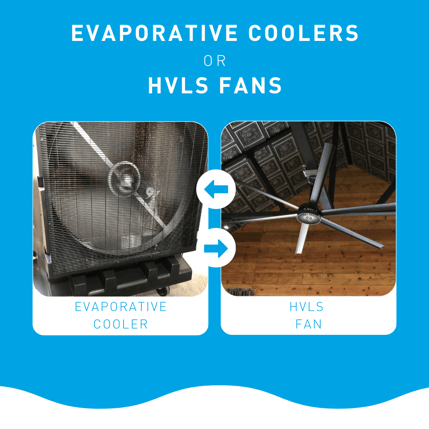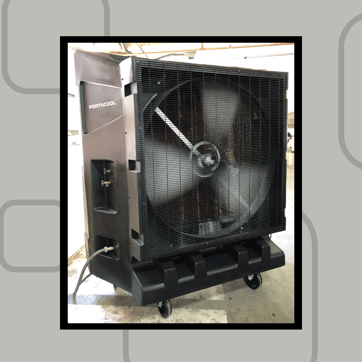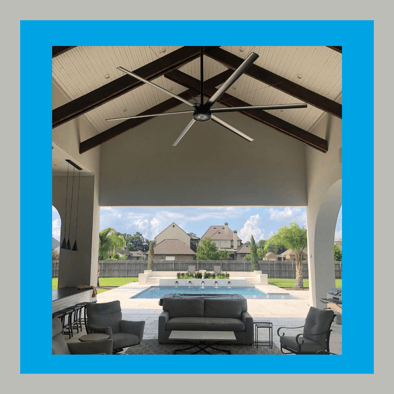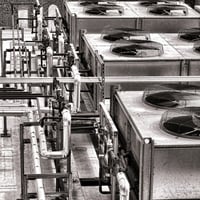If you're considering adding a fan to your home, shop, or commercial space, you may be wondering...
Evaporative Coolers VS HVLS Fans

Evaporative coolers, also known as swamp coolers, have long been a popular choice for cooling buildings in dry climates. They work by using a water pump to circulate water over a wet pad or media pad, which then evaporates and cools the air that is blown into a room. This process of evaporation is a natural form of cooling, and it can be an effective and energy efficient option in hot and dry climates.
However, evaporative coolers may not be the best choice for all types of buildings and climates. In humid environments, for example, the air may already be saturated with moisture, which can reduce the effectiveness of evaporative cooling. In these cases, traditional air conditioners or HVLS (High Volume Low Speed) fans may be a better option.
In this blog we will look more closely at the specifics of two effective forms of cooling, evaporative coolers, and HVLS fans, highlighting three key features of each. In addition, we’ll provide a comparison discussing both similarities and differences between the two types of cooling options.
What is an Evaporative Cooler?

An evaporative cooler, also known as a swamp cooler, is a type of air conditioning system that uses the process of evaporation to cool the air. It consists of a wet pad or media pad, water pump, and centrifugal fan. Wet pads or media pads are literally pads typically made of absorbent material able to hold a large amount of water. The pads are soaked in water before the cooler is turned on, and as the hot, dry air is drawn into the cooler, it comes into contact with the wet pad, causing some of the water to evaporate and cool the air. The cooled air is then blown into a room or building.
Evaporative coolers are typically used in dry and hot climates. Evaporative coolers can reduce the ambient temperature by 5 -15 degrees, but are less effective in humid climates and may not be able to maintain a consistent temperature in a large space. They achieve maximum efficiency when temperatures are above 85 degrees and humidity is below 50%. They are a popular choice for residential and commercial buildings, including homes, offices, and warehouses.
Key Features
- Evaporative coolers offer an energy efficient and environmentally friendly alternative to traditional air conditioning systems. They use less energy and emit fewer greenhouse gasses, making them a sustainable option for cooling buildings.
- Evaporative coolers are relatively inexpensive to install and operate. They do not require complex mechanical systems or refrigerants, which means they can be a cost-effective option for cooling buildings.
- Evaporative coolers can be effective at cooling large spaces, especially in dry and hot climates. They work by drawing in hot and dry air, which is cooled by the evaporation process and then blown into the room. This can help to create a comfortable and refreshing indoor environment.
Evaporative coolers can be less effective in humid climates and may not be able to maintain a consistent temperature in a large space. They also require a steady supply of water and a water tank to operate, which can be an added expense for businesses. In addition, evaporative air coolers may not be as energy efficient as HVLS fans, especially in humid environments.
What is an HVLS Fan?

HVLS (High Volume Low Speed) fans are large, industrial-grade fans that are designed to move a large volume of air at a low speed. They are typically installed in warehouses, distribution centers, automotive shops or garages, gyms, barns, and commercial spaces like restaurants and bars. These big fans can help to cool and circulate air in a large space.
One common question people ask about HVLS fans is, “where can I put an HVLS fan?” Well, HVLS fans are suitable for a wide range of commercial and industrial buildings, and they can be used in any type of climate, including humid ones. They are often used as an alternative to traditional air conditioning systems, as they can help to reduce energy consumption and operating costs. Sizes of fans range from 6-24 feet in diameter.
Key Features
- HVLS fans are energy efficient and environmentally friendly. They use less energy than traditional air conditioners, and they emit fewer greenhouse gasses, which can help to reduce their overall environmental impact. In fact, they run for as little as $0.37 per day.
- HVLS fans are versatile and can be used in any type of climate. They do not require a supply of water or a water tank to operate like evaporative coolers do, which means they can be used in humid environments where evaporative cooling may not be effective.
- HVLS fans are effective at cooling large spaces and maintaining a consistent and comfortable air temperature. They can circulate and evenly distribute the air throughout a room, which can help to maintain a comfortable temperature for employees and customers. They are also relatively quiet and do not produce any noise or vibration that could disturb occupants.
One of the main advantages of HVLS fans is their ability to cool a large area without the need for expensive and energy-intensive air conditioners. Just one large fan has the ability to affect up to 20,000 square feet. In addition to large areas of coverage, studies show that HVLS fans can reduce the need for traditional air conditioning by up to 30%, which can significantly lower operating costs for businesses.
HVLS fans are also more environmentally friendly than traditional air conditioners. They use less energy and emit fewer greenhouse gasses, which can help to reduce their overall environmental impact. In addition, HVLS fans do not release any chemicals or pollutants into the air, making them a safer and healthier choice for occupants.
Another key benefit of HVLS fans is their ability to create a comfortable temperature in a large space. By circulating the air and evenly distributing it throughout the room, HVLS fans can help to maintain a consistent and comfortable temperature, even in hot and humid environments. This can be especially important for businesses that need to maintain a comfortable temperature for their employees or customers.
HVLS fan expert, MacroAir, has published an extensive list of questions and answers in its blog. Click the link to find out more: The Most Common Questions About HVLS Fans
How Do the Two Compare?

Now, let’s take a closer look at both evaporative coolers and HVLS fans and review key similarities and differences between the two.
Similarities
Energy efficient
- Both HVLS fans and evaporative coolers are relatively energy efficient compared to traditional ac systems. They use less energy and emit fewer greenhouse gasses, which can help to reduce operating costs and environmental impacts.
Effectiveness at cooling large spaces
- Both HVLS fans and evaporative coolers are designed to cool large spaces. They can both be effective at creating a comfortable and refreshing indoor environment in these types of buildings.
Differences
Suitability for different climates
- HVLS fans can be used in any type of climate, including humid ones, whereas evaporative coolers are typically more effective in dry and hot climates. In humid environments, the air may already be saturated with moisture, which can reduce the effectiveness of evaporative cooling.
Type of cooling
- HVLS fans work by circulating the air in a room and evenly distributing it throughout the space, whereas evaporative coolers use the process of evaporation to cool the air. Evaporative coolers require a wet pad or media pad that is soaked with water and a fan that blows air over the wet pad, causing the water to evaporate and cool the air. HVLS fans do not require a water supply or water tank to operate, while evaporative coolers do.
Price
- HVLS fans are generally more expensive to purchase upfront compared to evaporative coolers, with average costs, generally costing several thousand dollars per fan. Evaporative coolers tend to be less expensive, with average costs ranging from a few hundred dollars for a portable unit to several thousand dollars for a larger system. However, HVLS fans can be a more cost-effective option in the long run due to their lower operating costs and ability to cool large spaces evenly and efficiently. Evaporative coolers may require more frequent maintenance and have higher energy costs due to their reliance on electricity to power the cooling process. HVLS fans can provide additional benefits such as improved air circulation, which can help to reduce the need for additional heating or cooling equipment. While the initial investment in HVLS fans may be higher, their energy savings and other benefits can make them a more cost-effective choice over the lifetime of the equipment.
Final Thoughts

Overall, while evaporative coolers can be a good choice for cooling buildings in dry climates, they may not be the most effective or energy efficient option in all environments. HVLS fans, on the other hand, offer a more versatile and energy efficient solution for cooling large spaces in any type of climate. They can help to reduce operating costs and environmental impacts, while also providing a comfortable and consistent air temperature for employees and customers.
When considering evaporative coolers vs HVLS fans, it's important to consider the specific needs and characteristics of your building and climate. HVLS fans may be the better choice for businesses in humid climates, or for those looking for an energy efficient and environmentally friendly cooling solution.
We at MacroAir are the inventors of the HVLS fan. The OG! We look forward to showcasing our line of HVLS fans. There really is a solution for every type of space. Click the link below to learn more about each fan option.


